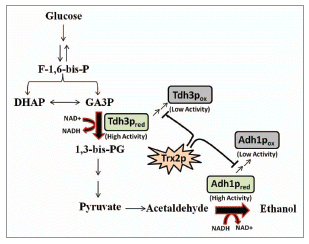Abstract
The beneficial effect of improving yeast redox response by increasing
thioredoxin levels has been shown. Decreased lipid and protein oxidation is reflected in
an increased biomass yield. In addition, increased redox defenses like glutathione and
ROS scavenging enzymes are observed. Furthermore, the wine produced with the
modified strain presented more aromatic compounds than the control strain, and its
organoleptic properties increased. Here, we hypothesize that reduced glycolytic enzyme
carbonylation can increase not only the glycolytic flux but also, and consequently, the
biomass yield in the industrial biomass propagation process. The commercial use of the
thioredoxin bioengineered yeast as an antioxidant dietetic supplement is also discussed.
Genetic bioengineering of industrial yeasts has been used to enhance many aspects relating to bread, wine, beer or other alcoholic beverages. However, very few studies have focused on the industrial production of yeast biomass, whose main challenge is to obtain high yields, but this is a difficult issue for modern bioengineering methods.Citation1 In several studies, increased yield has been ascribed to a new or enhanced capability of sugarCitation2 or nitrogen assimilation.Citation3 However, an increased yield during usual glucose metabolism has not yet been described.
We have recently shownCitation4 that enhancing the stress response of industrial yeast by increasing cytosolic thioredoxin may be beneficial for several aspects of yeast physiology. An increased Trx2p dosage (TTRX2 strain), the main thioredoxin isoform, has proved to lower cellular damage, for instance lipid and protein oxidation, during the industrial biomass propagation of wine yeasts. This overexpression influenced the redox stress response, and increased the activity of ROS scavenging enzymes and the amount of the antioxidant molecule glutathione.
The biomass propagation process consists in two main phases: the batch phase, in which metabolism is mainly fermentative, and the fed-batch phase, in which energy is obtained from metabolic sugar oxidation. Since thioredoxins are small proteins that protect against cellular oxidation, an important role during the fed-batch phase can be easily explained. However, we have observed that the most critical oxidative response takes place during the batch phase when fermentable sugars are exhausted and oxidation of ethanol starts. Molecular oxidation was especially abundant during this metabolic transition, which is probably due to an unbalanced NAD+/NADH ratio, the cofactors of alcohol dehydrogenase. The presence of increased levels of cytosolic thioredoxin appears to decrease oxidation during this metabolic transition.
One of the most interesting phenotypes of the TTRX2 strain is the increased biomass yield if compared to the control strain. We hypothesize that TTRX2 strain-specific enzymes will be less carbonylated than in the control strain and that they will be more efficient in their metabolic tasks. In fact, several enzymes of the central carbon metabolism, such as Adh1p and Tdh3p, have been identified as thioredoxin functional targets by our group (unpublished results) and others.Citation5 This increased glycolytic activity will increase glycolytic flux and favor yeast growth in glucose-limiting conditions like the fed-batch phase of the industrial biomass propagation process (). Many attempts have been made to increase the glycolytic flux rate by increasing enzyme concentration.Citation6 However, these approximations were not very successful due to the tight regulation of carbon central metabolism. In contrast, our strategy does not affect the enzyme protein levels, but enhances their efficiency by decreasing protein oxidation damage. This suggests that preventing the oxidation of enzymes can prove an interesting way to improve the flux of highly regulated metabolic pathways, especially in those processes involving metabolic oxidations.
Given their high vitamin and protein contents, yeasts have been widely used as both food supplements and dietetic products. Furthermore, the yeast strain Saccharomyces boulardii has been used as a probiotic as it is suitable for fighting intestinal infections.Citation7 On the other hand, thioredoxin has been proposed as a dietetic supplement because of its antioxidant capability which has been seen to decrease allergenicity.Citation8 Thus, the availability of a yeast strain with high levels of thioredoxin may be used to produce a dietary supplement with antioxidant properties and decreased allergenicity. Furthermore, the use of this wine yeast opens up the possibility of producing wines with a higher antioxidant thioredoxin content.
Addenum to:
References
- Pretorius IS. Tailoring wine yeast for the new millennium: novel approaches to the ancient art of winemaking. Yeast 2000; 16:675 - 729
- Gasent-Ramírez JM, Codón AC, Benítez T. Characterization of genetically transformed Saccharomyces cerevisiae baker's yeasts able to metabolize melibiose. Appl Environ Microbiol 1995; 61:2113 - 2121
- Salmon JM, Barre P. Improvement of nitrogen assimilation and fermentation kinetics under enological conditions by derepression of alternative nitrogen-assimilatory pathways in an industrial Saccharomyces cerevisiae strain. Appl Environ Microbiol 1998; 64:3831 - 3837
- Gómez-Pastor R, Pérez-Torrado R, Cabiscol E, Ros J, Matallana E. Reduction of oxidative cellular damage by overexpression of the thioredoxin TRX2 gene improves yield and quality of wine yeast dry active biomass. Microb Cell Fact 2010; 9:9
- Vignols F, Bréhélin C, Surdin-Kerjan Y, Thomas D, Meyer Y. A yeast two-hybrid knockout strain to explore thioredoxin-interacting proteins in vivo. Proc Natl Acad Sci USA 2005; 102:16729 - 16734
- Kern A, Tilley E, Hunter IS, Legisa M, Glieder A. Engineering primary metabolic pathways of industrial micro-organisms. J Biotechnol 2007; 129:6 - 29
- Guandalini S. Probiotics for children with diarrhea: an update. J Clin Gastroenterol 2008; 42:53 - 57
- Buchanan BB, Adamidi C, Lozano RM, Yee BC, Momma M, Kobrehel K, et al. Thioredoxin-linked mitigation of allergic responses to wheat. Proc Natl Acad Sci USA 1997; 94:5372 - 5377
